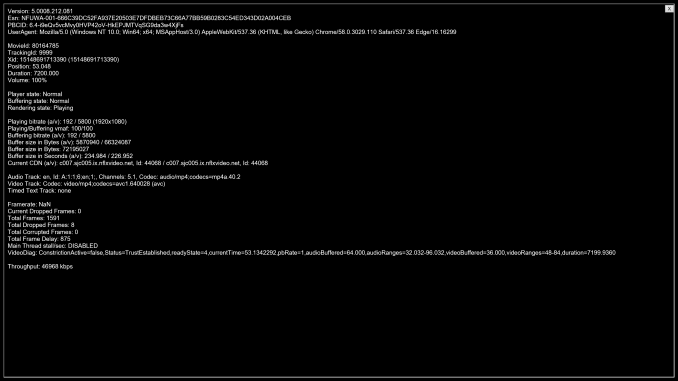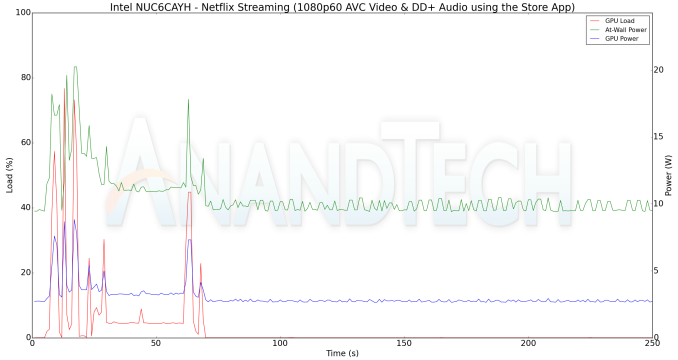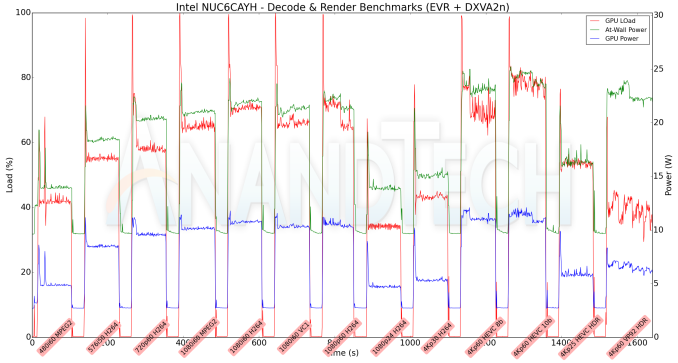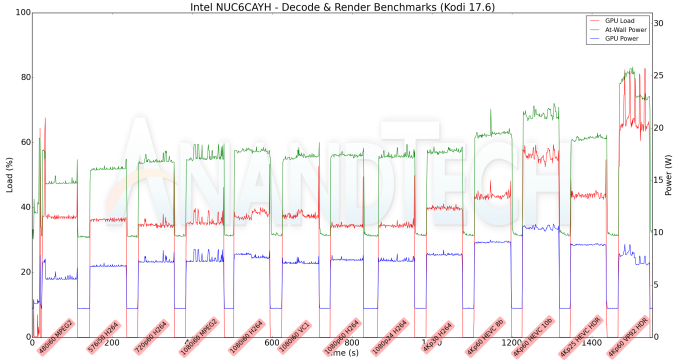Intel NUC6CAYH (Arches Canyon) Apollo Lake UCFF PC Review
by Ganesh T S on January 12, 2018 8:00 AM EST- Posted in
- Systems
- Intel
- NUC
- UCFF
- Apollo Lake
- Arches Canyon
4K HTPC Credentials
The Intel NUC6CAYH is actively cooled, but the fan curves are quite good. We were barely able to hear the fans at a distance of 6 ft. While not being as good as fanless unit with respect to acoustics, the NUC6CAYH fits the bill for a secondary / bedroom HTPC.
Refresh Rate Accuracy
Starting with Haswell, Intel, AMD and NVIDIA have been on par with respect to display refresh rate accuracy. The most important refresh rate for videophiles is obviously 23.976 Hz (the 23 Hz setting). As expected, the Intel NUC6CAYH has no trouble with refreshing the display appropriately in this setting.
The gallery below presents some of the other refresh rates that we tested out. The first statistic in madVR's OSD indicates the display refresh rate.
Network Streaming Efficiency
Evaluation of OTT playback efficiency was done by playing back the Mystery Box's Peru 8K HDR 60FPS video in YouTube using Microsoft Edge and Season 4 Episode 4 of the Netflix Test Pattern title using the Windows Store App.
The YouTube streaming test played back the 4K non-HDR version (VP9 video and Opus audio), while the Netflix one delivered the 1080p 5.8 Mbps AVC version.
The graph below shows the power consumption at the wall and the GPU loading parameters for the YouTube streaming case. Initially, the power consumption is a bit high as the video is fetched at a lower resolution (less taxing overall), but, needs to be scaled up for display. Later on, as the buffering stabilizes, the power consumption of the system (around 14W) and the GPU power (around 4.5W) settle down.
A similar graph for the Netflix streaming case is also presented below. Manual stream selection is available (Ctrl-Alt-Shift-S) and debug information / statistics can also be viewed (Ctrl-Alt-Shift-D). Statistics collected for the YouTube streaming experiment were also collected here. Despite the availability of a 4K display and HCP 2.2 support, I couldn't get Netflix to play back the 4K version of the title, even though the Apollo Lake NUC is supposed to be able to do it. On a hunch, I went back from the Fall Creators Update to the much older Anniversary Edition. That time around, I got the ULTRA HD 4K tag on the title, but, the playback was still that of the 1080p version 1080p, with the 4K stream option not visible at all.
It must be noted that the debug OSD is kept on till the stream reaches the 5.8 Mbps playback stage around 1.5 minutes after the start of the streaming. Toggling the state of the debug OSD results in variation in the at-wall power consumption (as much as 3W) and GPU loading parameters. In the steady state, we find that the at-wall and GPU power numbers are around 10W and 2.7W respectively.
Decoding and Rendering Benchmarks
In order to evaluate local file playback, we concentrate on Kodi and MPC-HC with EVR for the two systems. The integrated GPUs are too weak to handle madVR. We recently revamped our decode and rendering test suite, as described in our 2017 HTPC components guide. For the purpose of testing, we utilized Kodi 17.6, MPC-HC x64 1.7.13, and LAV Filters 0.70.1-83. The video decoder was set to native DXVA2 mode.
Playing back the SD and 1080p streams at 4K requires scaling, and that shows in the power numbers of the above graph. One point to note is that Apollo Lake does not support VP9 Profile 2 decoding, and the playback of the final stream in the above test suite was essentially a slideshow.
We see similar behavior with Kodi 17.6, as shown in the graph below.
Kodi turned out to be much better than MPC-HC, and we were happy to note that all streams except the VP9 Profile 2 one played back without any frame drops or stutters.
Finally, it must be noted that the GPU inside the Apollo Lake SoC does not support UHD Blu-ray playback despite the presence of a HDCP 2.2 HDMI 2.0 port. The SoC does not have SGX capabilities either.






















54 Comments
View All Comments
ganeshts - Friday, January 12, 2018 - link
Have you looked at the prices of RAM and flash lately? The Corsair kit was $90 when I was writing this review a week or so back (looks like it is $80 today), and the MX200 is relatively rare to find now (it was $250 when I was writing this). I think the cheapest equivalent today would be the BX300 480GB @ $145. So, the $470 price at the time of writing is probably closer to $355 now.That said, RAM and flash prices are fluctuating wildly due to the recent shortage. Things ought to become stable and a bit cheaper soon.
powellandy - Friday, January 12, 2018 - link
Do you have any comment on the ability to play 3D - looks like it's an ongoing saga with Intel chips -https://communities.intel.com/thread/112109
bill44 - Saturday, January 13, 2018 - link
Been following that thread, which is now dead. Intel won't/can't fix it. If they could, they've done it by now. Not enough customer complained (not to mention, 3D for the industry is dead), as such it just gets dragged out until everyone gives up.Going into the future, native HDMI 2.x may fix the issue, but going by past experience, there will always be problems with a HTPC setup (check out MadVR Madshi forums regarding constant driver issues).
powellandy - Monday, January 15, 2018 - link
I agree, but I was hoping if they mention it in the review and perhaps ask Intel it would put a bit of pressure on them to fix it!bji - Friday, January 12, 2018 - link
Do the benchmarks include Meltdown and Spectre fixes? If they don't, then the numbers are not accurate.ganeshts - Friday, January 12, 2018 - link
The benchmark numbers were processed before the security fixes started coming in. The relative numbers are still accurate when you compare one unit against the other (all of them in the comparison graphs are Intel-based systems).We are waiting for the dust to settle on all security fixes before embarking on any benchmark numbers regeneration procedures.
satai - Friday, January 12, 2018 - link
Some comparison to Core Ms would be nice.fuzzymath10 - Friday, January 12, 2018 - link
It's just "feel" based, but I bought my NUC (the same one + old Intel 320 160GB + 8GB ram + W10 Pro) to play videos on my 4k TV. Before, I temporarily used my Venue 7140 Pro with the 5Y10. The 5Y10 is faster for pretty much any "normal" task such as internet browsing which shouldn't be a surprise. Raw multithreaded might be more similar but the Core M is a smoother overall experience.However, the NUC supports 4k @ 60Hz while the HDMI from my Venue is only good to 30Hz. The NUC IGP can also decode HEVC while the HD 5300 in the Venue cannot, and the 5Y10 is not fast enough to software-decode most HEVC content (neither can the J3455). The Core M is also passively cooled while the NUC is semi-passive (fan can shut off).
Unfortunately, Core M is also very expensive. However, I would say the jump in user experience from the NUC to Core M is greater than from Core M to my desktop (i7 3770).
lilmoe - Friday, January 12, 2018 - link
Call me when Intel is capable of delivering anything remotely equal in terms of video/streaming playback performance and efficiency as my 2 year old Galaxy S7.Such incompetence, what a joke.
Hixbot - Friday, January 12, 2018 - link
Are you kidding? This nuc is leaps and bounds more powerful that your smartphone.